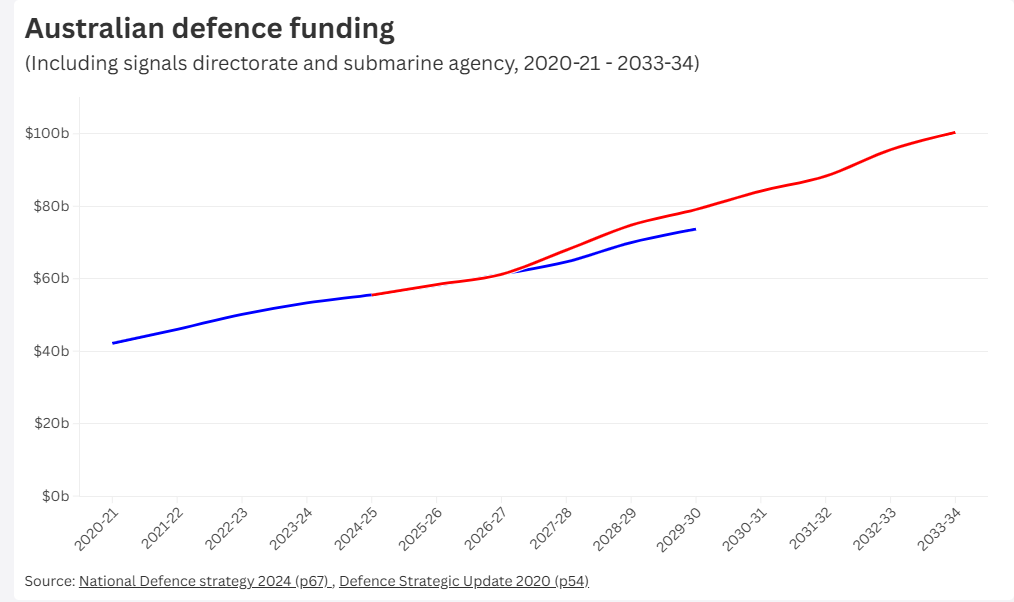Dutton wrong to claim Labor has cut $80 billion from defence
Matthew Elmas
April 29, 2025
WHAT WAS CLAIMED
Labor has taken $80 billion out of defence.
OUR VERDICT
False. Labor has raised defence spending by $50 billion over the next decade.

AAP FactCheck – Peter Dutton is falsely claiming that Labor has taken $80 billion out of defence amid the most precarious security situation since the end of Second World War.
Labor has increased defence funding over the next decade by more than $50 billion, compared to what the coalition had promised prior to losing power in 2022.
Defence under Labor has delayed, reprioritised and changed some projects to make room for spending on other capabilities like nuclear-powered submarines, experts explained.
But money has not been removed or cut from the defence budget.
Mr Dutton has made the false claim more than half a dozen times in April alone, switching between accusing Labor of ripping, taking out or cutting $80 billion from defence.
“The government’s taken about $80 billion out of defence at a time when the PM says we live in the most precarious period since the end of the Second World War,” Mr Dutton said in one media interview.
“Labor’s ripped $80 billion out of Defence,” he said in another interview.
On other occasions, Mr Dutton and opposition defence spokesperson Andrew Hastie have rephrased the claim and referred to the $80 billion figure as cuts, delays and reprioritisations across the defence portfolio.

Neither Mr Dutton nor Mr Hastie responded to AAP FactCheck’s request for evidence.
Marcus Hellyer, a defence budget expert who is head of research at Strategic Analysis Australia and an advisor for defence contractor C2 Robotics, said the straightforward answer is that Labor has not taken money out of defence and has instead increased funding.
He pointed to a 2020 document called the Defence Strategic Update (page 54), released under the coalition government, which sets out the annual defence budget across the decade to 2029-30.
The 2024 National Defence Strategy (p67), released under the Labor government, similarly sets out 10 years of funding to 2033/34.
Defence bosses also have access to longer-term forecasts associated with the 2020 and 2024 documents, which extend funding estimates beyond 2033/34, though these are not publicly available.
However, defence officials have said Labor has raised funding by $50.3 billion through to 2033/34 over the previous trajectory.
“That is new money,” Mr Hellyer told AAP FactCheck.
“The government has put more money into defence.”
Ahead of the May 3 federal election, the coalition has promised to lift defence funding by a further $20 billion over five years if elected.

Mr Hellyer and other defence experts approached by AAP FactCheck also pointed to another document known as the Integrated Investment Plan (IIP), which is prepared and regularly updated by department officials.
The IIP sits within the defence budget and keeps track of money intended to be spent on sustaining existing, and acquiring new, capabilities.
The Labor government did outline reprioritisations of projects totalling $72.8 billion in the 2024 IIP, including delays and funding reductions to some projects.
Mr Hastie recently pointed to several defence projects that have been scaled back under the IIP, including some F-35 fighter jets, infantry fighting vehicles and two supply ships.
Also, since the release of the IIP, the defence department announced it will no longer proceed with a satellite communications program valued at up to $7 billion.
However, Jennifer Parker, an expert associate at the Australian National University’s National Security College, said the IIP changes are not “money coming out of defence”.
The IIP is reviewed regularly and changes frequently, Ms Parker said, including money that’s “unapproved” – which is intended spending that’s yet to be signed off by the government.

Defence officials told Senate Estimates in 2024 that most of the funding reprioritised in the IIP wasn’t yet approved and was a mix of delays, re-scoped spending and even new projects.
The projects in the IIP were reduced from more than 540 to about 270, with 188 closed or merged into larger programs, 45 delayed, 16 reduced in scope and 32 added or accelerated.
The “vast majority” of projects that had already been approved by the government were not affected, Major General Anthony John Rawlins told estimates.
He said that a reprofiled project means the amount spent each year has been adjusted, while a delay takes existing funding for a project and pushes it back into later years.
Ms Parker said the IIP includes both public and classified programs, meaning only defence and the government know the full list of reprioritisations under the 2024 IIP.
“The reprioritisation of the IIP; I don’t think there’s any accurate way for you to characterise that as a cut to the defence budget,” Ms Parker said.
“You could say they reprioritised and delayed or re-scoped things the coalition think should have remained as priorities, but that’s not a cut to the defence budget, just a change in the types of capabilities that budget will be spent on and when.”

Adam Lockyer, a defence expert at Macquarie University, said much of the money that was reprioritised in the IIP was redirected to the acquisition of AUKUS nuclear-powered submarines.
“This would be best understood as moving money around rather than taking it out,” Associate Professor Lockyer told AAP FactCheck.
“But this is serious money, and defence is feeling the pinch. They are cutting back wherever possible – in their day-to-day expenditures – to fund the submarines.”
Mr Hellyer said the reprioritisations reflected an “oversubscribed” defence budget when Labor came to power that included tens of billions for future projects.
The 2023 Defence Strategic Review (p95) identified $42 billion in spending over the decade to 2033 which was announced but was not actually provisioned for in the federal budget.
“The Albanese government inherited this kind of very ambitious shopping list that there wasn’t enough money for,” Mr Hellyer said.
Mr Hellyer said any government would have faced this problem, which was worsened by increasing inflation eating away at the purchasing power of the defence budget in 2023.
“I don’t think it’s accurate to say that $70 or $80 billion has been taken out of the defence budget,” he said.
Mr Hellyer explained that much of the additional funding Labor has poured into defence has been directed to the AUKUS nuclear-powered submarine program and a new set of warships, known as the future frigate program.
AAP FactCheck is an accredited member of the International Fact-Checking Network. To keep up with our latest fact checks, follow us on Facebook, Instagram, Threads, X, BlueSky, TikTok and YouTube. (AAP)



